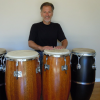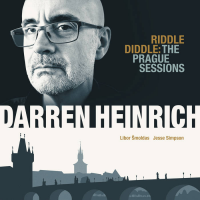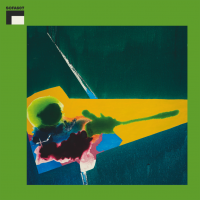Home » Jazz Articles » Album Review » Gyedu-Blay Ambolley: Gyedu-Blay Ambolley And Hi-Life Jazz
Gyedu-Blay Ambolley: Gyedu-Blay Ambolley And Hi-Life Jazz
In the 1970s, as electric guitars became commonplace in Ghana, a third style emerged, known as "guitar band highlife." What binds the three strands together are generally sunny, upbeat tunes and a relaxed but insistent five-beat rhythm, played on claves, which became known in the US as the "Bo Diddley beat" or "postman's knock."
Most urban bandleaders give their own spin on highlife a special name, which is often more a marketing device than an indication of real singularity. The tenor saxophonist and vocalist Gyedu-Blay Ambolley emerged in the early 1970s out of the great Uhuru Dance Band, calling his soul and and funk-infused style Simigwa. It is not a million miles away from the makossa music the Cameroonian saxophonist Manu Dibango created in the late 1960s. Over thirty-five own-name albums later, Ambolley continues to delight audiences in Ghana and the Ghanaian diaspora.
In varying degrees, jazz has always been part of dance band highlife, and on Gyedu-Blay Ambolley And Hi-Life Jazz Ambolley gives it a pronounced emphasis, including covers of John Coltrane's "A Love Supreme," Wayne Shorter's "Footprints," Thelonious Monk's "'Round Midnight" and Miles Davis's "All Blues," each of them built around the signature claves beat. Two different lineups, each including some talented horn soloists in addition to the leader, offer amiable, groove-centric instrumental music to which Ambolley sometimes adds Isaac Hayes-like spoken-word observations using both English and Ghanaian languages. There is nothing here which will frighten the horses, and nor is that the intention. The music is meant to keep the listener feeling good and dancing, even if only in the head. And it does.
Postscript: A more rough-edged fusion of jazz and highlife was developed by the South African trumpeter Hugh Masekela on his albums with Ghanaian highlife band Hedzoleh Soundz in the mid 1970s: Introducing Hedzoleh Soundz (Blue Thumb, 1973), I Am Not Afraid (Blue Thumb, 1974), The Boy's Doin' It (Casablanca, 1975) and Colonial Man (Casablanca, 1976). The first two in particular are highly recommended.
Track Listing
Sankumagye Love Life; Yekor Ye A Yeaba; Enyidado; Love Supreme; Footprints; Round Midnite; Asamansudo Groove; All Blues; Ambolley Special.
Personnel
Gyedu-Blay Ambolley
saxophone, tenorIsaacs Karikari
keyboardsPeter Mensah Kadesh
drumsGeorge Abban
guitarKuuku Antonio
trumpetColonel Faat
saxophone, tenorShikome
percussionRob Berends
saxophone, baritoneSteven Smith
trumpetMichael Session
saxophone, altoJohn Rangel
pianoJosman Mbela
drumsAl Threats
bass, electricMarcel Adjibi
congasAdditional Instrumentation
Tracks 1-4, 6, 7, 9: Gyedu-Blay Ambolley: tenor saxophone, percussion, vocals; Isaacs Karikari: keyboards; Peter Mensah Kadesh: drums, percussion, backup vocals; Charles O.Donkor: bass guitar, guitar (3), backup vocals; George Abban: guitar; Owura Kay: guitar solo (4); Dominic Quachie: guitar solo (9); Kuuku Antonio: trumpet, flugelhorn, backup vocals; Colonel Faat: tenor saxophone solos; Shikome: congas, backup vocals, percussion; Rob Berings: baritone saxophone, additional keyboards, percussion; Rob de Lange: wah wah guitar. Tracks 5, 8: Gyedu-Blay Ambolley tenor saxophone, percussion, vocals. Steven Smith: flugelhorn; Michael Session: alto saxophone; John Rangel: piano; Josman Mbela; drums; Al Threats: bass; Marcel Adjibi: congas.
Album information
Title: Gyedu-Blay Ambolley And Hi-Life Jazz | Year Released: 2022 | Record Label: Agogo Records
Tags
About Gyedu-Blay Ambolley
Instrument: Saxophone, tenor
PREVIOUS / NEXT
Support All About Jazz
 All About Jazz has been a pillar of jazz since 1995, championing it as an art form and, more importantly, supporting the musicians who make it. Our enduring commitment has made "AAJ" one of the most culturally important websites of its kind, read by hundreds of thousands of fans, musicians and industry figures every month.
All About Jazz has been a pillar of jazz since 1995, championing it as an art form and, more importantly, supporting the musicians who make it. Our enduring commitment has made "AAJ" one of the most culturally important websites of its kind, read by hundreds of thousands of fans, musicians and industry figures every month.




















